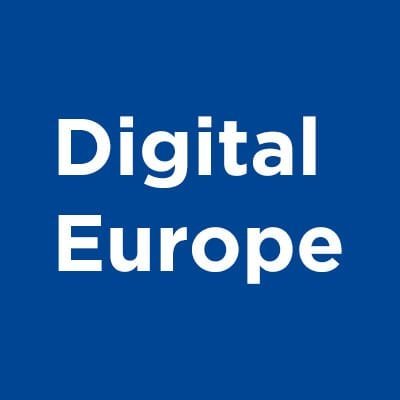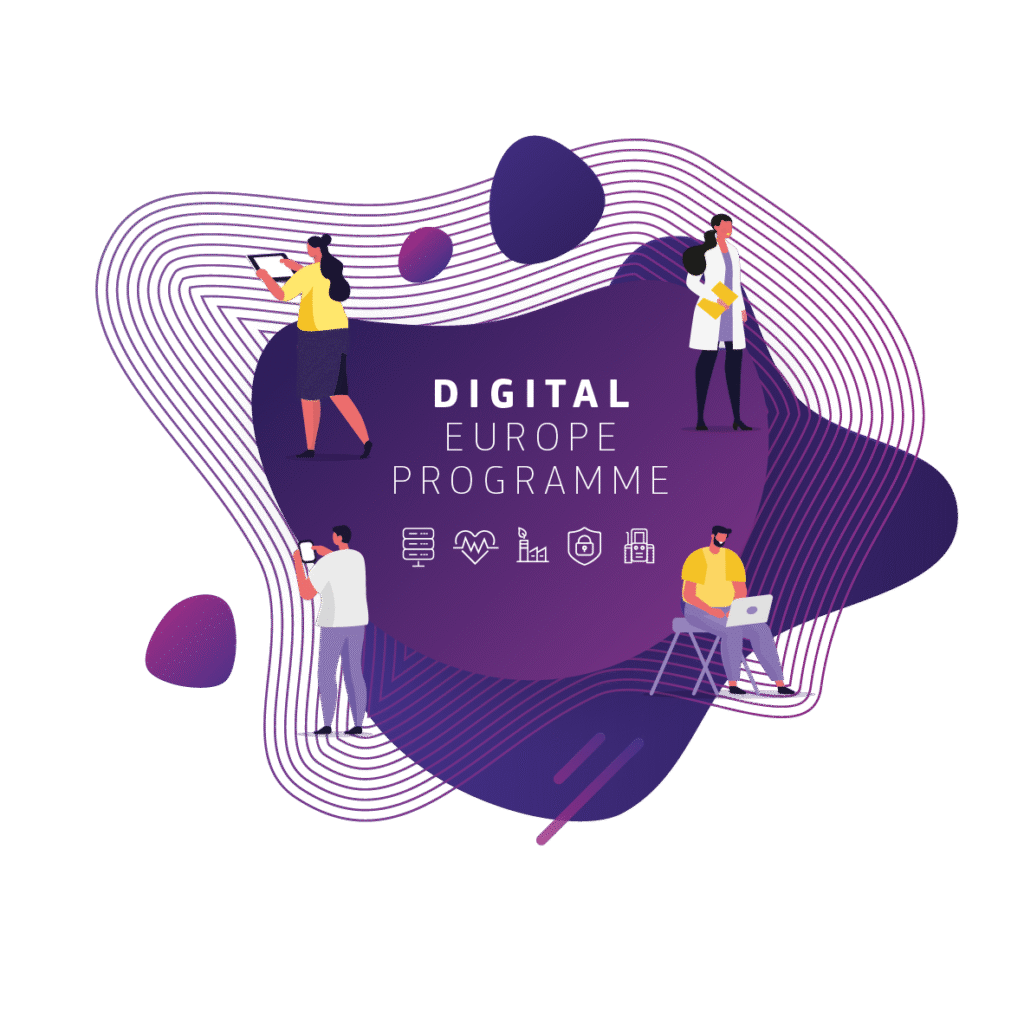Digital Europe Programme
European funding for digital transformation
- Welcome
- EU funding program
- Digital Europe
Summary
Introduction to the Digital Europe program
The Digital Europe (DIGITAL) programme is the first European funding programme entirely dedicated to the digital transformation of the European economy and society. Launched for the period 2021–2027, this €7.5 billion strategic programme aims to stimulate investment in critical digital capabilities and the deployment of advanced digital technologies across Europe.

Within the European financing ecosystem, Digital Europe occupies a unique and complementary position. Unlike Horizon Europe Focusing on research and innovation, Digital Europe is geared towards the deployment, adoption, and use of digital technologies. While the Connecting Europe Facility finances trans-European digital infrastructure, and structural funds support regional digital cohesion, Digital Europe fills a crucial gap by targeting strategic digital capabilities and their practical implementation.
Digital Europe's strategic objectives are fully aligned with the European vision of digital sovereignty and inclusive digital transformation. The program aims to:
- Strengthening Europe's technological sovereignty in strategic digital areas
- Democratize access to advanced digital technologies and skills
- Accelerating the adoption of digital technologies by businesses and the public sector
- Supporting the interoperability of digital solutions across Europe
- Contributing to European resilience and digital autonomy in the face of global competition
Digital Europe is structured around five key areas of intervention, with dedicated budgets:
- High-performance computing (€2.2 billion)
- Artificial intelligence (€2.1 billion)
- Cybersecurity and trust (€1.6 billion)
- Advanced digital skills (€577 million)
- Deployment and better use of digital capacities (€1.1 billion)
Building the digital Europe of tomorrow
Specific objectives and priorities
The Digital Europe programme represents the EU's most ambitious investment ever in strategic digital technologies. It combines the development of cutting-edge capabilities with their practical deployment in the economy and society, creating a vital bridge between innovation and real-world impact.

Main thematic axes
Digital Europe is structured around five major complementary and interdependent thematic axes:
High-performance computing (HPC)
- Creation of a world-class European supercomputer infrastructure
- Development of exascale and post-exascale supercomputers
- Expanding the use of HPC in areas of public interest
- Development of the European high-performance computing ecosystem
- Industrial applications of HPC for innovation
Artificial Intelligence (AI)
- Creation of common European data spaces in strategic sectors
- Development and strengthening of AI capacities in Europe
- Establishment of AI testing and experimentation facilities
- Promoting ethical, reliable and human-centered AI
- Deployment of AI platforms accessible to SMEs and public administrations
Cybersecurity and Trust
- Strengthening European cybersecurity capacities
- Deployment of advanced tools, equipment and infrastructure
- Support for the implementation of the NIS2 directive
- Development of cybersecurity infrastructure and tools
- Protection of critical infrastructure and the digital economy
Advanced digital skills
- Training in advanced digital skills (AI, HPC, cybersecurity, blockchain)
- Design and implementation of specialized training programs
- Internships and training in the professional environment
- Development of masters and advanced training
- Retraining and upskilling of professionals
Deployment and optimal use of digital capacities
- Digital transformation of public administrations
- Interoperability of public services across Europe
- Deployment, adoption and use of digital technologies
- European Digital Innovation Hubs (EDIH)
- Large-scale deployment projects in sectors of public interest
Sectoral priorities
The Digital Europe programme supports, in particular, green digital technologies that contribute to climate objectives, in complementarity with theInnovation Fund which finances industrial decarbonization technologies on a larger scale.
Beyond the five main axes, Digital Europe pays particular attention to applications in key sectors:
- Health and care (electronic medical records, telemedicine, medical AI)
- Connected and autonomous mobility (autonomous vehicles, intelligent transport systems)
- Digital twins for industry and smart cities
- Industry 4.0 and smart manufacturing
- Public administration and digital public services
- Sustainable agriculture and environment
- Digital culture and heritage
- Digital education and training
The programme places particular emphasis on the creation of European data spaces in these sectors, enabling the secure sharing and use of data at European level.
European strategic objectives supported
Digital Europe is part of the major European strategic guidelines, in particular:
- Europe's Digital Decade and its objectives for 2030
- The European data strategy
- Technological sovereignty and European strategic autonomy
- The European Green Deal and sustainable digital transformation
- The European ecosystem of excellence and trust in AI
- The European cybersecurity strategy
- Modernization of European public administrations
Expected impact at European level
Digital Europe projects must demonstrate their potential to generate significant impacts:
- Strengthening European strategic digital capacities
- Democratization of access to advanced digital technologies
- Reducing the digital divide between regions and populations
- Creation of a functional digital single market
- Accelerating the digitalization of SMEs and the public sector
- Development of a competitive and sovereign European digital ecosystem
- Creation of highly qualified jobs in the digital sector

Types of projects funded
Digital Europe finances different types of actions depending on the objectives pursued:
- Simple Grants :
- Digital technology deployment and adoption projects
- Typical duration: 12-36 months
- Co-financing: 50% in general (up to 75% in certain cases)
- Consortium generally required (exceptions possible)
- Actions for the deployment and operation of European digital infrastructures (DIGITAL European Infrastructures) :
- Creation and operation of pan-European digital infrastructures
- Typical duration: 24-60 months
- Co-financing: 50-75% depending on the case
- Consortium generally made up of public or parapublic entities
- Public procurement :
- Acquisition of digital capacities and infrastructures by the Commission
- Calls for tenders for specific services, solutions or equipment
- Financing generally at 100%
- European Digital Innovation Hubs (EDIH) :
- One-stop shops helping businesses and public organizations in their digital transformation
- Co-financed at 50% by the EU and 50% by Member States or regions
- Selected through a two-stage process involving national nominations and a European call
Concrete examples of projects already funded
Here are some illustrative examples of projects that have benefited from Digital Europe funding:
- Creation of a European network of AI testing and experimentation infrastructures for the manufacturing industry
- Development of a European blockchain-based services platform for public administrations
- Establishment of a common European health data space enabling secure access to medical records across the EU
- Creation of a network of cybersecurity centers covering different strategic industrial sectors
- Deployment of an advanced training program in AI and cybersecurity for 20,000 European specialists
- Creation of a high-performance computing infrastructure dedicated to innovative SMEs in strategic sectors
Supported technological innovations
Digital Europe particularly supports projects which:
- Deploy advanced digital technologies that have moved beyond the R&D phase
- Promote the adoption and use of European digital solutions
- Develop strategic and shared digital infrastructures
- Strengthen the interoperability of digital systems across Europe
- Develop cutting-edge digital skills to meet market needs
Use digital technology to address societal and environmental challenges
Priority sectors
Although Digital Europe covers all economic sectors, certain areas receive particular attention:
- Digital public services and connected administrations
- Digital health and personalized medicine
- Industry 4.0 and digitalized value chains
- Smart and connected mobility
- Smart cities and communities
- Smart energy and sustainable networks
- Digital agrifood and traceability
- Digital Finance and Financial Technologies
- Education and skills in the digital age

Support by MarketKaps

Specific expertise on this program
Marketkaps has extensive expertise in the Digital Europe program, a result of our involvement and successful support of public and private organizations across Europe. Our team includes experts and evaluators who are fully conversant with Digital Europe's evaluation criteria and specific priorities.
Our experts combine technical expertise in the five key areas of the program (HPC, AI, cybersecurity, digital skills, deployment), in-depth understanding of financing mechanisms and concrete experience in setting up complex transnational projects.


Personalized support methodology
Our support approach for Digital Europe follows a proven 6-step methodology:
- Strategic analysis : Evaluation of your technology or digital solution and alignment with Digital Europe priorities
- Optimal positioning : Identification of the area of intervention and the type of action most suited to your project
- Consortium design : Creation of a balanced and complementary European partnership (if necessary)
- Project structuring : Definition of work packages, deliverables and expected impacts
- File assembly : Development of a complete proposal, aligned with the evaluation criteria
- Negotiation and contractualization : Assistance in the preparation phases of the grant agreement

Services offered
Marketkaps offers complete or modular support according to your needs:
- Eligibility diagnosis and strategic positioning
- Monitoring of Digital Europe calls for projects
- Research and mobilization of European partners
- Technical and administrative structuring of the project
- Complete drafting of the application file
- Budget preparation and compliance verification
- Preparation for evaluators' questions
- Assistance in negotiating the grant agreement
- European project management training
- Support for technical and financial reporting

Eligibility conditions
Eligibility criteria for organizations
To be eligible for the Digital Europe programme, candidates must meet the following conditions:
- Legal entities established in an eligible country:
- EU Member States
- EEA countries (Norway, Iceland, Liechtenstein)
- Associated countries having signed a specific agreement with Digital Europe
- In certain specific cases, non-associated third country entities (with restrictions)
- Types of eligible organizations :
- Public entities (national, regional, local authorities)
- Private organizations (companies, associations, foundations)
- International organizations (under specific conditions)
For most actions, a consortium of several partners is required, with generally a minimum of 3 independent entities from 3 different eligible countries. Some specific calls may have different requirements.
Types of businesses concerned
Digital Europe is accessible to a wide range of organizations:
- SMEs and startups : Particularly targeted by certain calls and EDIH
- Large companies : Generally as partners providing expertise and deployment capacity
- Public bodies : Administrations, local authorities, public agencies
- Research centers and universities : For their advanced technological capabilities
- Sectoral associations and clusters : Facilitating the adoption of digital technologies
- NGOs and non-profit organizations : Particularly in projects with a societal dimension
Some calls may prioritize specific types of organizations or require particular combinations in consortia.
Geographic criteria
The Digital Europe programme is mainly open to:
- 27 Member States of the European Union
- Countries of the European Economic Area (Norway, Iceland, Liechtenstein)
- Associated countries having concluded a specific agreement with the program
Entities from non-associated third countries may exceptionally participate without funding in cases justified by the objectives of the project and the interest of the EU.
The program encourages balanced geographical representation in consortia and pays particular attention to the inclusion of less digitally advanced regions.
Technical or scientific prerequisites
Digital Europe projects must meet several technical criteria:
- Technological maturity level : Focus on technologies that have passed the R&D stage, generally TRL 6-9
- Deployment orientation : Projects must aim for the concrete adoption, use and deployment of technologies
- European dimension : Clear added value at European level (not just national)
- Interoperability : Compliance with relevant European norms and standards
- Sustainability : Credible strategy for sustainability after the end of funding
- Security and data protection : Compliance with GDPR and European cybersecurity requirements
Projects must generally demonstrate a balance between technological innovation and deployment feasibility.


Financing arrangements
Financing rates by type of organization
Funding rates in Digital Europe vary depending on the type of action and sometimes on the type of organization:
- Simple Grants :
- Standard rate: 50% of eligible costs
- Possible exceptions up to 75% for certain specific calls
- No differentiation according to the type of organization
- Actions for European digital infrastructures :
- 50-75% depending on the specifics of the call
- Higher funding possible for critical components
- European Digital Innovation Hubs (EDIH) :
- 50% funded by the EU
- 50% co-financed by Member States or regions
- Public markets :
- Financing at 100%
Grant ceilings
Funding amounts vary considerably across calls for proposals:
- Simple actions : Generally between 1 and 10 million euros
- European digital infrastructures : Can reach several tens of millions of euros
- EDIH : Around 1-1.5 million euros per year per hub for the EU contribution
- Advanced digital skills training actions : Typically 1-5 million euros
Annual work programmes and specific calls define precise budget ranges.
Eligible costs
Generally eligible cost categories include:
- Personnel costs : Salaries and expenses of the teams working on the project
- Subcontracting : Outsourced services (with limits depending on calls)
- Purchase of equipment and infrastructure : Often a major position in Digital Europe projects
- Travel and accommodation expenses : For project-related meetings, conferences and events
- Other direct costs : Consumables, distribution, validation, certifications, etc.
- Indirect costs : Package of 7% of eligible direct costs
Digital Europe generally uses the actual cost model, where expenses actually incurred are reimbursed at the applicable financing rate.
Co-financing required
The Digital Europe programme operates on the principle of co-financing:
- The majority of actions require co-financing of at least 50% of eligible costs
- This co-financing may come from the beneficiary's own resources or from other sources (national, regional, private)
- For EDIH, co-financing of 50% must come from Member States or regions
- Certain strategic actions may benefit from a higher financing rate (up to 75%)
- In-kind contributions may be accepted under certain conditions
Marketkaps can help you identify sources of co-financing and structure your financial plan optimally.


Application Process
Calendar and calls for projects
Digital Europe operates according to a system of calls for proposals published regularly:
- Work program : Strategic document defining priorities over 2 years
- Calls for proposals : Published on the Commission's Funding & Tenders portal
- Frequency : Several waves of calls each year, covering different priorities
- Submission deadlines : Usually 2-3 months after the call is published
- Assessment : 3-5 months after the call closes
- Contractualization : 2-3 months after the assessment results
- Project launch : Generally 8-9 months after the call is published
Required documents
The Digital Europe application requires the preparation of several key documents:
- Administrative forms (Part A):
- General information about the project
- Administrative data of participants
- Detailed budget
- Ethical and Safety Self-Declarations
- Technical description (Part B):
- Detailed description of the project (context, objectives, impact)
- Work plan (work packages, deliverables, milestones)
- Description of the consortium and allocation of resources
- Communication, dissemination and exploitation strategy
- Annexes (according to calls) :
- CVs of key people
- Letters of support
- Descriptions of existing infrastructure
- Specific documents required by certain calls
Marketkaps supports you in the preparation of each of these documents, paying particular attention to alignment with the evaluation criteria and specific objectives of Digital Europe.
Submission Steps
The Digital Europe submission process includes the following steps:
- Caller ID relevant on the Funding & Tenders portal
- Creating an account and registration of your organization (if not already done)
- Preparation of the proposal according to the templates and guidelines provided
- Constitution of the consortium and collection of information from partners
- Collaborative writing of the different parts of the proposal
- Compliance verification with all administrative requirements
- Electronic submission before the deadline (anticipation recommended)
- Confirmation of receipt automatic by the system
For certain specific calls, such as EDIH, the process may include preliminary national pre-selection stages.
Proposal evaluation criteria
Digital Europe projects are evaluated according to three main criteria:
- Relevance :
- Alignment with the objectives and priorities of the call
- Contribution to European policies and strategies
- European added value
- Implementation :
- Quality and efficiency of the work plan
- Operational capacity and complementarity of the consortium
- Appropriate allocation of resources
- Risk management and quality assurance
- Impact (Impact) :
- Short, medium and long-term effects of the project
- Measures to maximize impact (dissemination, exploitation)
- Sustainability and prospect of larger-scale deployment
Each criterion is generally marked out of 5 points, with a minimum threshold of 3/5 per criterion and an overall threshold of 10/15.
Marketkaps optimizes your application to maximize your score on each of these criteria, with particular attention to demonstrating concrete impact and European added value.


Success rates and key factors
Success statistics for this program
The Digital Europe programme, being relatively recent, has the following characteristics in terms of success rate:
- Overall average success rate : Approximately 15-20% on a European scale
- Variation by domain :
- High Performance Computing: 10-15% (very competitive)
- Artificial Intelligence: 15-20%
- Cybersecurity: 15-25%
- Advanced Digital Skills: 20-30%
- Capacity Deployment: 15-25%
- Variation by type of action : European infrastructures are generally more competitive (10-15%) than single actions (20-25%)
- Competition : Increasing trend with the ramp-up of the program
- Geographic distribution : Slight over-representation of Western and Nordic European countries, but efforts to balance
Common Mistakes to Avoid
Our experience has allowed us to identify the main errors that penalize Digital Europe applications:
- Excessive focus on R&D : Propose a research project rather than a deployment project
- Insufficient European dimension : Failure to clearly demonstrate transnational added value
- Unbalanced Consortium : Lack of complementarity or absence of key players in the value chain
- Neglected interoperability : Insufficient consideration of European standards and norms
- Impact too vague : Lack of precise metrics and KPIs to measure success
- Sustainability misaddressed : Unconvincing strategy for sustainability after funding
- Weak political alignment : Insufficient connection with European digital policies and strategies
- Poorly calibrated budget : Unbalanced or insufficiently justified allocation of resources
Marketkaps ensures that these weak points are corrected before submission to maximize your chances of success.
Differentiating factors for a successful application
The factors that make the difference in obtaining Digital Europe funding are:
- Strategic alignment perfect with the specific objectives of the program and the call
- Concrete and measurable impact demonstrated by clear and realistic metrics
- Balanced consortium including users, developers and facilitators
- Demonstration of deployment with a specific plan for adoption by end users
- European dimension with clear cross-border added value
- Interoperability and openness conform to European standards and principles
- Sustainability Plan credible for the post-financing period
- Synergy with other initiatives European, national and regional
Marketkaps feedback
Our experience in supporting Digital Europe projects has enabled us to identify best practices:
- Early involvement of end users and stakeholders is critical to success
- Projects that demonstrate concrete synergies with other initiatives have a competitive advantage
- Accurate quantification of the expected impact, with relevant KPIs, significantly strengthens the application
- A careful balance between ambition and realism is crucial – evaluators value ambitious but achievable goals
- The clear articulation with national and regional digital strategies reinforces the credibility of the project
- Effective visualization of concepts and expected outcomes significantly improves evaluators' understanding
- Projects that take into account geographic diversity and the inclusion of less digitally advanced regions are generally better evaluated
- A well-targeted communication and dissemination strategy demonstrates the ability to maximize the impact of the project

FAQ on the Digital Europe programme
Frequently Asked Questions by Businesses
What is the difference between Digital Europe and Horizon Europe?
Most Digital Europe initiatives require a transnational consortium, typically comprising at least three independent entities from three different eligible countries. However, some specific calls, particularly within the framework of Digital Innovation Hubs (EDIHs) or certain initiatives directly targeting SMEs, may allow individual applications. Furthermore, SMEs can still benefit from the services offered by EDIHs even without directly participating in a funded project. Marketkaps can guide you toward the opportunities best suited to your situation.
Can an SME participate alone or is a consortium required?
Digital Europe primarily targets technologies that are already past the R&D stage, typically at a Technology Readiness Level (TRL) of 6 to 9. The program does not fund the development of new technologies, but rather their deployment, adoption, and use. Your solution must therefore already be tested and validated, ready for larger-scale implementation or application in new contexts.
What level of technological maturity is expected?
Digital Europe funding can complement national and regional funding, particularly in the context of EDIH, which is explicitly co-financed at 50% by Member States or regions. For other actions, the rules on cumulating public aid apply in accordance with European regulations. An effective strategy often involves combining different funding sources to maximize the impact of your digital project, while ensuring compliance with state aid rules.
How can Digital Europe help innovative startups?
Although Digital Europe is not specifically designed for direct funding of startups like theEIC Accelerator, it offers many opportunities through the Digital Innovation Hubs (EDIH) which provide support services, technology testing and market access for young innovative companies.
How are national/regional funding coordinated with Digital Europe?
Digital Europe funding can complement national and regional funding, particularly in the context of EDIH, which is explicitly co-financed at 50% by Member States or regions. For other actions, the rules on cumulating public aid apply in accordance with European regulations. An effective strategy often involves combining different funding sources to maximize the impact of your digital project, while ensuring compliance with state aid rules.
How do European Digital Innovation Hubs (EDIH) work in practice?
EDIHs are one-stop shops that help businesses and public sector organizations meet digital challenges and become more competitive. They operate on four pillars:
- Test before investment : Opportunity to experiment with advanced digital technologies (AI, HPC, cybersecurity) before investing
- Training and skills development : Training programs to improve employees' digital skills
- Support for digital transformation : Advice, expertise and methodologies for implementing technologies
- Networking and ecosystem : Connection with the innovation ecosystem, investors and other companies
Each EDIH generally has a sectoral or technological specialization and operates in a network with other European hubs. They are selected through a two-stage process (national pre-selection then European selection) and are co-financed 50% by the EU and 50% by the Member States or regions.
How to maximize synergies with other European programs?
To optimize the use of European funding, several approaches are possible:
- Time sequencing : Use Horizon Europe for R&D, then Digital Europe for deployment
- Thematic complementarity : Funding different aspects of a global digital strategy through multiple programs
- Geographic expansion : Deploy a validated solution in new regions via structural funds
- Financial leverage : Using Digital Europe as a catalyst to attract InvestEU or EIB funding
- Capacity building : Combine Digital Europe with Erasmus+ or ESF+ for training aspects
Marketkaps can help you develop a coherent long-term European financing strategy, by identifying optimal synergies between different programs.
Maximize your chances of success with our expertise
Ready to launch your Digital Europe application
Marketkaps supports you every step of the way, from initial assessment to final submission, to maximize your chances of securing Digital Europe funding and contributing to Europe's digital transformation.
Please contact us with any questions or to discuss your digital project. Together, let's help strengthen Europe's digital capabilities and build a sovereign and inclusive digital future.


